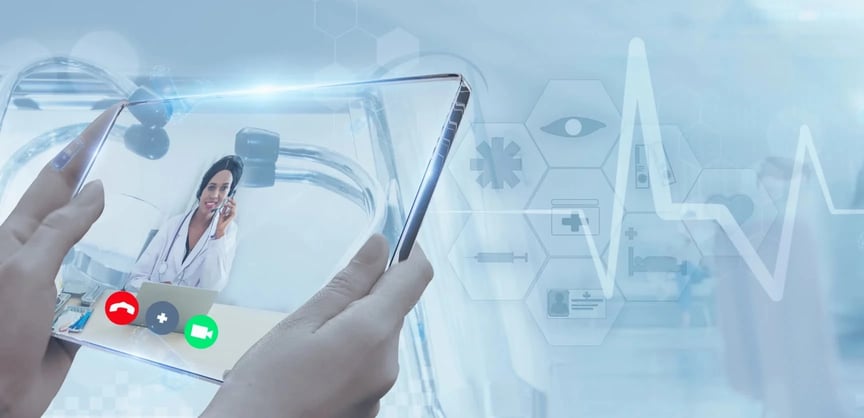- Product
-
Solution
-
By Industry
Cybersecurity solutions tailored to your industry’s needs.
-
- Resources
-
Books
Our ultimate guides and playbooks
Solution Briefs
Overview of PureDome’s functionality
-
Quizzes
Assess your cybersecurity readiness
Case Studies
PureDome customer success stories
Newsletter
Subscribe to the PureDome newsletter
-
- About Us
- Partner
- Pricing
- Download
Securing Telehealth: Navigating the Challenges of Remote Healthcare
-
Sharmeen Saleem
-
30 Jan 2024
- 7 min read


As telehealth services rely on digital platforms, patients must transmit personal information via the Internet, including sensitive financial data encoded within the healthcare service's internal systems. Without robust cybersecurity measures and regulatory safeguards, this information becomes a tempting target for hackers and cybercriminals.
According to Alex Heid, the Chief Research and Development Officer at SecurityScorecard, telehealth applications expand the digital presence of healthcare organizations, rendering them more susceptible to cyberattacks. For instance, malware infections, phishing attacks, and other cybercrimes have led to a staggering 77% decrease in the IP reputation security of medical institutions. Consequently, their digital services are less secure and more vulnerable to data breaches.
This heightened vulnerability has also attracted hackers who seek to compromise telehealth vendors to gain access to patient's health information for potential digital identity theft. Despite the inherent risks in storing patient data, such information is vital for accurate diagnoses. Therefore, the telehealth industry must intensify its efforts to bolster data security.
Regrettably, telehealth is just one of the many digital services cybercriminals target. The transition to digital services in the wake of the pandemic has seen a doubling in cyber incidents. Alarmingly, the cybersecurity workforce is currently outnumbered by these malicious actors. David Shearer, CEO of the largest association of certified cybersecurity professionals, highlights the staggering need for four million trained cybersecurity experts to safeguard digital services, including telehealth.
What are the Key Cybersecurity Concerns in Telemedicine?
Telemedicine has revolutionized healthcare by allowing doctors, nurses, and patients to communicate without exposing anyone to unnecessary health risks. However, it's imperative to recognize this technology's security and privacy risks. Here are some critical concerns:
Limited Control Over Patient Data
The increasing use of the Internet of Things (IoT) and connected devices in healthcare enables real-time patient monitoring. While these devices are crucial for patient safety, the data they transmit must be secured. Patients often consent to the collection and transmission of medical data, but these devices may also capture non-medical activities and data, such as interactions with family or other private activities. This data can be stored by device or app manufacturers, not just healthcare providers, and may be sold to third parties for targeted advertising or medical fraud. Patients may need to understand the implications of data collection fully, and privacy policies are often overlooked. Collecting unnecessary data that is not medically relevant can violate the HIPAA Privacy Rule, which aims to give individuals control over their protected health information (PHI).
Bring Your Own Device (BYOD)
Many healthcare organizations allow employees to use their personal devices for work purposes, known as Bring Your Own Device (BYOD). While these devices may access healthcare systems and patient records through VPN solutions for businesses, more is needed to ensure endpoint security. Healthcare professionals working from home may use various devices, including tablets, computers, and cell phones, increasing the risk of data breaches. To mitigate these risks, healthcare professionals must ensure that no PHI is stored on personal devices and that each device can be remotely wiped in case of loss or theft. Security measures may be harder to enforce on devices that do not directly belong to the healthcare provider, leading to potential security gaps.
Non-HIPAA Compliant Video Conferencing
The rapid growth of telemedicine in 2020 led to the swift development of telehealth platforms. Unfortunately, this rapid development sometimes resulted in security and privacy being overlooked. Video conferencing apps used in telemedicine are only sometimes ideal for compliance with the Health Insurance Portability and Accountability Act (HIPAA) Privacy Rule, which governs the security of patient data. Although the Office for Civil Rights temporarily relaxed some HIPAA regulations during the pandemic, allowing conventional video conferencing programs like Zoom and Skype, these platforms may not provide adequate security for PHI. This regulation relaxation increases the risk of PHI being collected or sold to third parties without robust security measures.
Security Risks of Working from Home
Remote work has become common for healthcare employees and contractors. As more individuals access healthcare networks remotely, monitoring all users and detecting fraudulent or unauthorized access becomes challenging.
To enhance security and ensure secure connectivity for employees and patients alike, healthcare organizations should consider these tips for remote work:
- Avoid connecting to public Wi-Fi.
- Restrict work-related activities to work computers.
- Encrypt sensitive data when sharing via email or cloud services.
- Provide ongoing security training for all employees.
- Implement a remote work policy as part of the overall data security strategy.
These precautions can help mitigate the security risks associated with remote work in healthcare.
Emerging Challenges in Telemedicine Risk Management
As advancements in communication technology propel us into a digital age, telemedicine services have surged in popularity. This innovative healthcare approach offers numerous benefits for patients and practitioners but conceals risks requiring solutions from risk managers and policy management teams.
Telehealth practices, now widely accepted in the medical field and regulated by authorities across the United States and worldwide, present unforeseen liability issues from a risk management perspective.
Patient Data Security and Privacy
The responsibility for safeguarding critical data, such as medical records and personal identifying information, shifts to IT systems in telehealth practices. The security of this data assumes paramount importance, mainly due to healthcare-specific privacy laws like HIPAA. Policy management organizations must ensure that the telehealth system incorporates the latest security measures to protect patient data effectively.
Geo-specific Coverage and Liability
Medical professionals typically hold licenses to practice within their state. However, when utilizing telemedicine systems, they may inadvertently treat patients residing outside their authorized geographical area. This situation raises liability concerns, particularly in malpractice or patient dissatisfaction cases. While physicians must address this issue individually, risk management teams must remain vigilant about potential complications.
Technical Risks in System Functionality
Introducing any new technology invariably introduces inherent risks associated with the system itself. While organizations often focus on security, the hardware and software underpinning telemedicine can introduce hidden risks to the process. Regular maintenance, timely updates, and adaptation to new technological advancements become imperative. With risk managers at the helm, health organizations can leverage their expertise to establish appropriate service schedules.
Patients may also encounter technical challenges in their medical communication and treatment. Some individuals need access to reliable, secure Internet connections and suitable hardware. Others engage in risky behaviors that jeopardize data privacy and security. Patient education becomes integral to a distance doctor's responsibilities to enhance their self-protection.
Effective risk management involves identifying and proactively resolving potential issues, which becomes even more critical in telehealth due to the heightened potential for severe problems like misdiagnosis, insurance fraud, HIPAA violations, and more. Monitoring technology, ensuring patient access only in covered locations, and meticulous insurance policy management constitute essential measures in preventing these and other complications.
Risks in Telehealth Software
Telehealth users encounter various security concerns, which encompass:
Risks from Insecure Patient Data Transmission
Within telemedicine, PHI and other patient information may traverse devices lacking the robust security protocols established by medical practices, heightening security vulnerabilities. Inadequately secured data transmissions are incompatible with telehealth security and privacy standards. For instance, if medication data were transmitted without proper security, hackers could intercept it for nefarious purposes. To address these risks, proactive measures must be taken to address privacy and security concerns in telehealth.
Patient Data Privacy and Security
Compliance with HIPAA mandates that healthcare providers protect the confidentiality of patients' personal healthcare information (PHI) and promptly notify patients in case of data breaches. Alarming statistics reveal 1,461 data breaches involving the healthcare records of nearly 170 million individuals in the U.S. over the past decade. Safeguarding communication devices and methods is imperative to thwart potential data breaches by hackers or malicious entities. Maintaining telehealth privacy and security measures is indispensable for preserving patient data privacy and security.
Security Challenges with Medical Devices & Applications
Medical devices, such as heart monitors, glucose monitors, and insulin pumps, may not incorporate the same robust security features as the computers utilized in telemedicine, giving rise to telehealth cybersecurity risks, including the potential theft of patient data. Many of these devices are remotely monitored via the internet; however, without proper security measures, this data becomes vulnerable to capture by hackers—either during transmission or by accessing stored data on the device.
Insecure and Non-Private Computers and Systems
Specific systems and computers used in telehealth procedures may lack the security measures to protect sensitive health information adequately. In the current landscape, with a substantial portion of the workforce operating remotely, the software employed may be exposed to malware threats due to insecure connections between diverse communication technologies. Telemedicine security risks emerge as a consequence of such vulnerabilities. Unprotected computers, whether at home or within medical facilities, remain susceptible to compromise by hackers. Some hospitals have fallen victim to ransomware attacks wherein cybercriminals breach their IT systems and hold critical data hostage.
In the evolving landscape of telehealth, addressing these multifaceted challenges and risks is paramount to ensuring the privacy, security, and integrity of patient data and healthcare processes.
Essential Security Measures for Telehealth Providers to Prevent Breaches

To safeguard telehealth systems and prevent unauthorized access, telehealth providers should implement robust security measures. These measures include:
Multi-Factor Authentication (MFA) & Single Sign-On (SSO)
Implementing MFA and SSO for all users is crucial in preventing unauthorized access, particularly from bots and malware. MFA adds a layer of security by requiring users to provide multiple forms of identification before granting access. SSO streamlines the authentication process, ensuring secure and efficient access to multiple systems with a single set of credentials.
Continuous Device Monitoring
Telehealth providers should maintain ongoing device monitoring to detect signs of compromise or infection. Infected devices should be promptly identified and removed from the network to prevent further spread of malware to other devices.
Vendor Partner Security
Reviewing contracts with third-party vendors ensures all partners adhere to appropriate security measures and compliance requirements. Telehealth providers must collaborate with vendors who prioritize patient privacy and meet compliance standards. Defining security expectations and establishing protocols for responding to potential threats in these partnerships is crucial.
Employee Training
The effectiveness of a security strategy is closely tied to employee awareness and readiness. Telehealth providers should invest in comprehensive training programs for their staff. Training should cover technology solutions, common cyber threats, and healthcare-specific risks. Ensuring employees are proficient in using programs and devices securely promotes the widespread adoption of secure practices.
While telehealth offers numerous benefits, achieving and maintaining compliance with regulations like HIPAA often requires a layered approach to security. Telehealth providers can protect patient data, collaborate with other healthcare stakeholders, and deliver safe and effective care by prioritizing encryption and other security measures. To better understand encryption's role in security and HIPAA compliance, consider referring to our HIPAA Guide for Email and File Protection.
Addressing Telehealth Security Challenges: Solutions and Measures
Telehealth security issues, though formidable, can be effectively addressed with the right solutions and measures. Ensuring telehealth and health information security necessitates collaboration with experts who can provide tailored solutions to establish a secure operational environment.
The investment in cybersecurity programs for telehealth services is justifiable, given the potential harm caused by security breaches. Here are key security measures to tackle telemedicine privacy and security concerns:
Secure Endpoints
Endpoints, including laptops, tablets, smartphones, and office computers, can pose security risks, particularly in telecommuting scenarios. Prioritize telehealth privacy and security by employing data encryption for all data transfers, especially those involving protected health information (PHI).
Verify HIPAA Compliance
To maintain compliance, partner with applications and vendors that have undergone independent validation for HIPAA compliance. Use mobile app notification platforms to closely monitor any emerging issues related to HIPAA telehealth security.
Utilize High-Performance Technology
Practical telehealth sessions, including video conferencing with patients, demand high-performance technology. Invest in technology that supports seamless telehealth sessions and customization options to tailor applications to your practice's specific needs. Look for platforms that offer telehealth security mobile access to enhance accessibility.
Establish Cybersecurity Guidelines for PHI Protection
To safeguard PHI as mandated by HIPAA, establish policies and provide training to counter telemedicine security threats. This is crucial, especially for devices handling PHI offsite, such as staff members telecommuting. Implement multi-factor authentication to bolster PHI security and reduce the risk of security breaches from stolen passwords.
Wrapping Up
PHI breaches often result from lost or stolen computing equipment, employee errors, or third-party oversights. The outlined initiatives offer telehealth security measures to effectively secure PHI, enabling medical practices and patients to benefit from integrating telemedicine and cybersecurity into their operations.
Telehealth presents numerous advantages to medical practices and patients. While security risks exist, partnering with experts can help minimize these risks, allowing clinics to leverage telehealth benefits without compromising patient data security.
PureDome offers a comprehensive cybersecurity solution to assist you in securing your telehealth services against cyber threats while maximizing the benefits for your practice and patients.
Frequently Asked Questions
What are the primary security threats in telehealth?
The primary security threats in telehealth include patient data breaches, unsecured data transmission, inadequate device and system security, and non-compliance with regulations like HIPAA.
How can I ensure the privacy of patient data in telehealth?
To ensure patient data privacy, use secure telehealth solutions, partner with cybersecurity experts, conduct employee training, and implement multi-factor authentication for added security.
What is HIPAA compliance in telehealth, and why is it important?
HIPAA compliance in telehealth involves adhering to regulations that protect patient data. It's crucial as it ensures the confidentiality and security of patients' personal healthcare information.
What are the risks associated with unsecured transmission of patient data in telehealth?
Unsecured transmission of patient data can lead to interception by hackers, potentially exposing sensitive information. Implement data encryption to mitigate this risk.
How can healthcare providers secure endpoints in telehealth?
Healthcare providers can secure endpoints using data encryption for all data transfers, especially those involving protected health information (PHI).
Stay up to date with the latest cybersecurity insights and best practices
Get the latest information, stories, and resources in your inbox. Subscribe for monthly updates.
Securing 1000+ Businesses Across The World